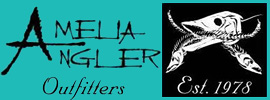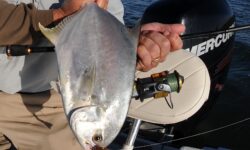Author: Terry Lacoss
96965 Buccaneer Trail
Amelia Island, Fl. 32034
Title: “Amelia Island Beach Trout”
Caption: Savvy Northeast Florida speck fishermen find plenty of spotted sea trout action where sloughs, jetties and piers along the beach make for a perfect ambush.
Shades of light creeping skyward offshore of Amelia Island's beaches greeted Northeast Florida residents Wilson Tennille, Darrell Blanton, Mike Price and Marvin Leininger for a morning of beach fishing. However instead of unloading 12-14 foot surf rods and fishing reels filled with heavy line from their four wheel drive SUV, the foursome of seasoned saltwater fishermen had brought along 7-foot spinning rods and reels filled with long casting braided fishing lines.
“Our main objective was to arrive at the beach just before the morning sun had begun to shine light on the calm morning ocean,” Wilson Tennille said. “Keep in mind that past fishing experiences here always led to fast sea trout action until the sun was shinning bright on our favorite beach fishing spot.”
“Also a nice point about fishing here with light spinning tackle, we would be casting all artificial lures and did not have to deal with purchasing or cast netting live baits. Our lures of choice were noisey surface plugs worked close to schools of mullet.”
Soon the small group of beach fishermen were casting their hard plastic plugs from waist deep water to key areas of the “Little Jetty” rocks where nervous schools of finger mullet indicated feeding sea trout just under the surface.
Keep in mind that the “Little Jetty” rocks were strategically constructed where deep beach waters greet a series of shallow bars located at the very southern tip of Amelia Island. Shallow bars and the constant tidal flow from Nassau Sound affords for ideal mullet and menhaden habitat, particularly during the warmer months of spring, summer and fall.
“As the sun began to peek over the horizon bait fish activity increased dramatically,” Wilson Tennile said. “With great anticipation I made a long cast engaging my spinning reel where a nervous school of finger mullet was holding. Bringing my surface plug to life with short pumps from my rod tip produced luring “Chugs and Pops” followed by and explosive trout strike. The vicious trout strike resulted in a missed hook-up. I continued to work my surface walker back to the beach and on the outskirts of the small mullet school. It wasn't long before my surface plug came under attack once more by a small army of beach trout. This time the sharp saltwater hooks found their mark and I was playing a fat beach trout as the suns warming rays welcomed a new day of beach fishing.”
The foursome of seasoned saltwater fishermen enjoyed fast topwater sea trout action during the low light period of early dawn. However as the sun's rays increased, the surface fishing action began to dwindle as well.
“We typically work Rapala “Skitter Walk” and Mirr-0-lure “Top Dog” surface plugs when the trout are on a good early morning topwater bite,” Marvin Leininger said. “The key when trout fishing during early morning is to have the big schools of mullet working at the “Little Jetty” rocks. We also use mullet pattern surface plugs and make our cast where the mullet schools are plentiful. We also fill our spinning reels with 14-pound moss colored braided fishing line while employing a 3-foot 20-pound section of fluorocarbon shock leader. I personally do not keep any of the trout that I catch while mashing down the barbs of my topwater plugs. Barbless hooks certainly make it easier to release my trout while also avoiding getting hooked!”
Without a doubt the best time to target beach trout during late spring all summer is early in the morning when the sun is just preparing to make it's daily rounds. However beach fishing for trout along the beaches at the southern portion of Amelia Island is also excellent during the fall and winter fishing seasons when the sun is setting and after dark too. Here the water temperatures warm up during late afternoon producing ideal fishing conditions as the sun retires for the night. Cam Harrison heads up Fernandina Beach's Middle School football program and also offers excellent advice on catching Amelia Island beach trout.
“I prefer to fish during late summer, fall and early winter at the Southern portion of Amelia Island,” Cam Harrison said. “”American Beach” offers excellent beach trout fishing during an incoming tide. Definitely a hard bottom at “American Beach” attracts a lot of bait fish and trout too. Here I will wade out into a slough where the water depth is 6-8 feet of water and work a Mirr-0-Lure “Catch-2000” in the red head and silver body color pattern.”
“If the tide is falling I prefer to trout fish at the “Little Jetty Rocks” located at the very southern portion of Amelia Island. Here the trout fishing is best when the tide is falling late in the afternoon and after dark too. My beach trout fishing tactic here is to wade out to the rocks waist deep and cast a ¼ ounce led head jig rigged with a plastic twister tail in the clear with silver metal flake color pattern. I will make long casts to either ends of the jetty rocks while working the jig and plastic tail super slow along the bottom. One thing that I have found is that beach trout are mostly all keepers running from 16-20 inches. My largest beach speck so far weighed just over six pounds.”
“A trout fisherman recently gave up his spot at the Little Jetties allowing me to wade out into the very same spot located at the foot of the “Little Jetties”, Cam Harrison said “I made 23-casts and while catching my limit of six-beach trout. The beach fishermen was a little upset that he had left his spot and had not caught any trout. I did a little “Coaching” on his casting and trout fishing tactics and he was soon a happy trout fisherman!”
Cam Harrison also fills his spinning reels with 8-pound test Spider Wire Ultra Cast Ultimate mono fishing line while employing a 12-inch fluorocarbon shock leader. Also cam has a luring way in coaching beach trout to his trout lures that amaze nearby beach fishermen!
“I like to beach fish for trout at the southend of Amelia Island when there has been a long period of stable weather with little wind,” Amelia Island's Captain Benny Hendrix said. “This typically affords for clean water conditions and a good trout bite. Since I am a charter captain and often on a fishing charter in the morning, I usually have the afternoons available to fish at my leisure. Also I like to find the schools of small finger mullet running along the beaches at the southern tip of Amelia Island. Its always a good sign when finger mullet are holding close to the “Little Jetty” rocks because I know that beach trout will be more than likely holding there as well. However I often walk the beach at the south end of the island looking for mullet that are holding hard hitting sea trout too. Also keep in mind that if small menhaden are holding at the Little Jetties and along the beaches, big beach trout are sure to mixed in with menhaden schools.”
Beach trout fishermen casting D.O.A. “TerrorEyz” weighted lures to beach trout holding at the “Little Jetties” late in the afternoon and after dark also do well. The weighted lure affords for long cast and does a terrific job in luring late evening beach trout. Here trout fishermen often employ the light colored pearl/chartreuse colored TerrorEyz while there is still good light. As darkness approaches and after dark, the green/red tail and the motor oil color patterns work best. Obviously the D.O.A. shrimp is also an excellent choice when fished under a “Popping” float when the surf is calm.
Naturally live baits also work well while targeting “Little Jetty” and beach trout at Amelia Island. Some of the largest Amelia Island beach sea trout are taken while fishing live finger mullet with a “Fish-Finder” setup. The fish finder setup begins with a one ounce egg weight threaded on to your 20-pound braided fishing line. Next a small plastic bead is also threaded onto your terminal fishing line followed by a 30-pound black barrel swivel that is attached to the main line using a palomar knot. Next an 18-inch length of 20-pound fluorocarbon shock leader is attached to the remaining side of the barrel swivel. Finally a #2 kahle hook is tied to the business end of the leader. Live finger mullet are barbed right through the bottom of the mouth and out through the top of the head and fished slowly along the bottom just behind large rolling swells, or at the foot of the “Little Jetty” rocks. Just bring along a 6-8 foot, 5/8th-inch cast net and net your live finger mullet right from the surf. Live finger mullet can be kept in a live bait bucket that is conveniently tied to the beach fisherman's waist.
Live shrimp can also be used with great success while targeting beach trout and are available at a number of bait shops located on Amelia Island. Here it is advised to have on hand a five-gallon live bait bucket to house your live shrimp for both transporting and fishing for beach trout.
Also keep in mind that trout fishing at the southern tip of Amelia Island and at the “Little Jetty” rocks can also be excellent during daytime, winter or summer.
The “Little Jetties” were constructed in 2004 to stop beach erosion. Also the lose of valuable beaches here was a huge concern in protecting shorebird and sea turtle nesting as well and good reasoning for constructing the rock groin.
Amelia Island State Park located at the southern tip of Amelia island and the foot of the “George Grady” public fishing pier affords for easy access both on foot and driving to the “Little Jetties”. Non-Nassau County residents are required to purchase a $6 beach driving permit. A $2.00 park fee per person is also required. Disabled or handicapped persons are not required to purchase a permit. The Nassau County Historic Courthouse located at 416 Centre St., 904-491-7430, sells beach driving permits and all Flash Food stores located on Amelia Island sell beach driving permits as well.
“I annually purchase a $125.00 park permit which allows me to carry up to eight persons with me and I can access any of Florida's state parks,” Cam Harrison said.
I if you do access the beaches at the southern tip of Amelia Island through the Florida State Park at Nassau Sound, it is advised to have a four wheel drive SUV.
“I carry along a “Tow Strap” in my truck and have pulled more than one vehicle out of the sand,” Marvin Leininger said. “Also avoid stringing fish off in the water. A good fishing friend of mine George Morgan had a shark feeding on his stringer of trout in waist deep water. That was the last time good old George stringer any fish off from his belt!”












